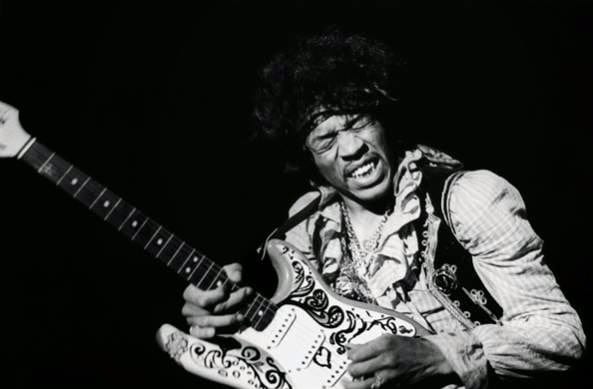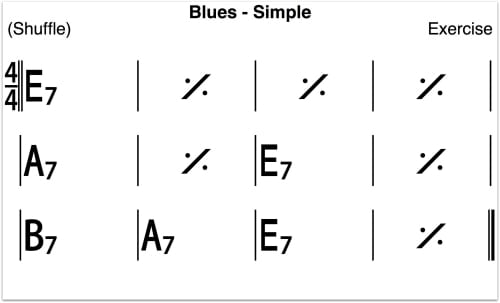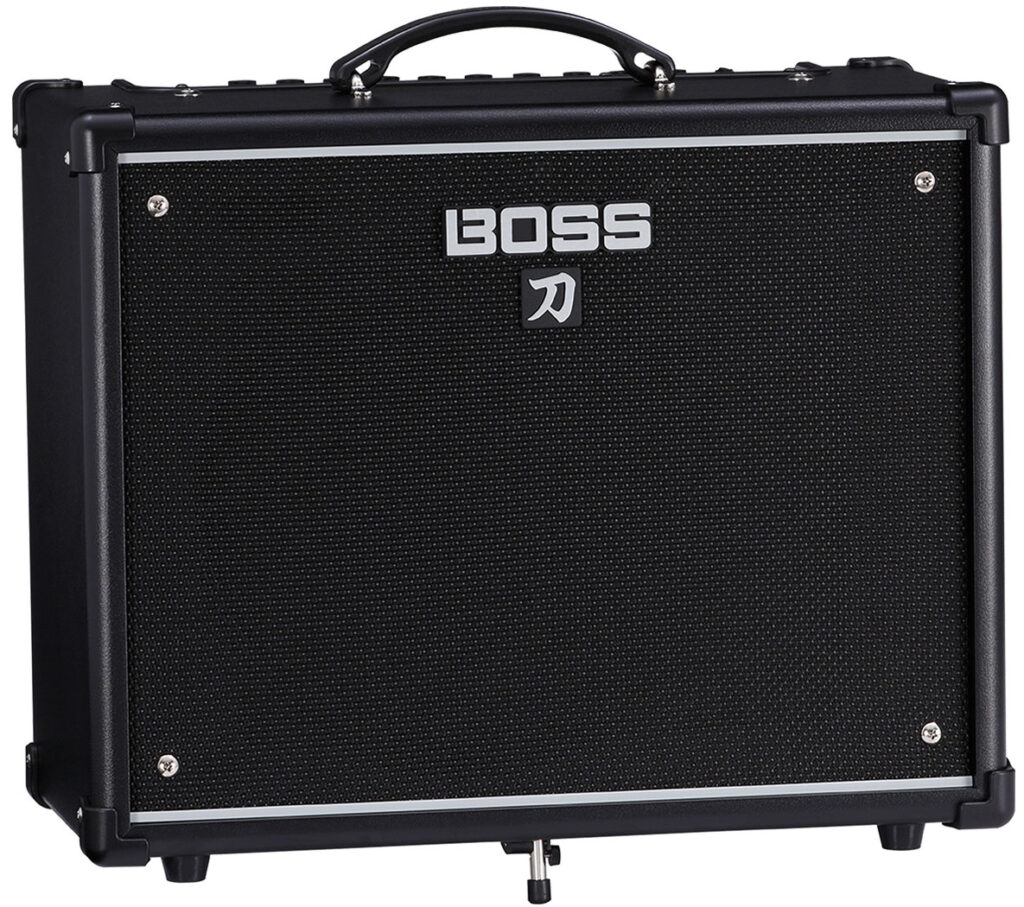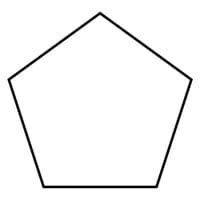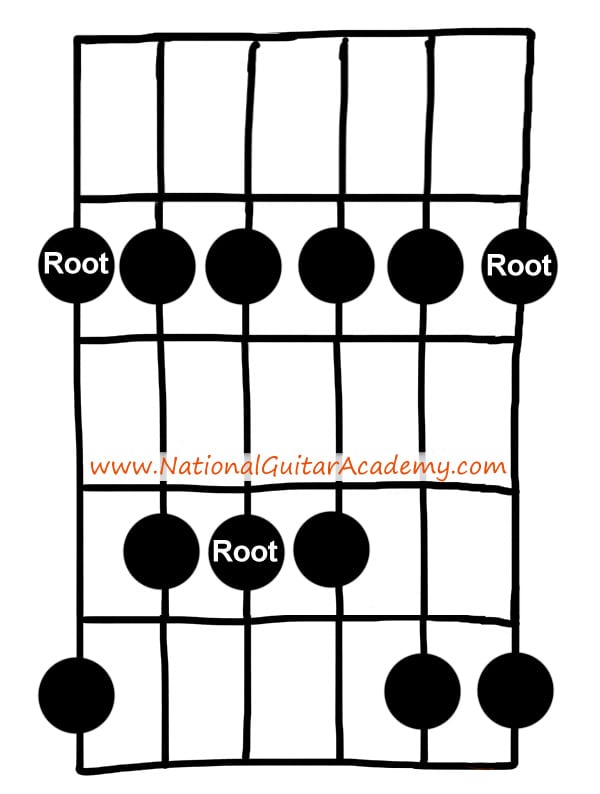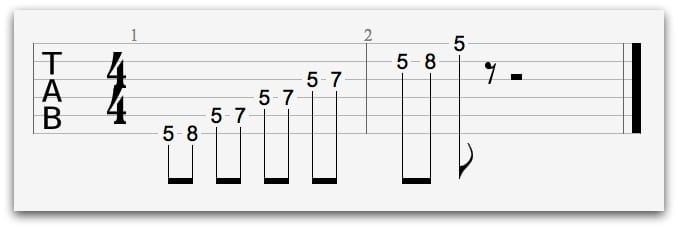Wondering how to play lead guitar? We’ve got your back. This is the latest in our ‘Ultimate Guide’ series of guitar lessons; these articles are crafted with great care and designed to teach beginner guitarists at lightning speed. Let’s dive in!
In this Ultimate Guide you will learn:
How To Play Lead Guitar: Part 1 – Lead guitar introduction: Understanding the role of a lead guitarist
- What do people mean when they refer to ‘lead guitar’?
- What is the role of a lead guitarist?
- An overview of the 3 most common guitar ‘roles’: bass, rhythm & lead.
- What does a lead guitarist actually do?
- A great example of well-rounded lead guitar style (video).
How To Play Lead Guitar: Part 2 – Learn about the lead guitarist’s secret weapon: Keys
- Understanding the all-conquering importance of a song’s key.
- Why lead guitarists MUST know the key of a song (& why it makes things easy).
- How to identify the key of a song.
- How to find a scale that will work with the song’s key.
How To Play Lead Guitar: Part 3 – Guitar scales decoded: A simple explanation, at last!
- What is a scale?
- The two scales every guitarist must know
- The Major Scale & the Minor Scale
- The Major Pentatonic Scale
- The Minor Pentatonic Scale
- How to play a scale
- Scales & relative minors
How To Play Lead Guitar: Part 4 – How to use the CAGED system to sound amazing with alternate chord voicings
- An introduction to the CAGED system
- Examples of the CAGED system in practice
- CAGED system made easy
- How To use triads to sound amazing
How To Play Lead Guitar: Part 5 – The tricks of the trade for lead guitarists
- Improvisation tips and riff exercises
- Understanding string-bending (video)
- How to slide between notes (video)
- How to use vibrato to add polish to your lead guitar technique (video)
- Using hammer-ons and pull offs
- Why root notes rule (and how to use them)
- Active listening and some classic lead guitar ‘phrases’
- 3 practice riff exercises & practice backing track
NOTE: This guide is easy to read but there’s a lot here (decades of wisdom and experience!) so you may want to bookmark this page for future reference. This will be a guide you can refer back to again and again.
.
Over 100,000 guitar-learners get our world-class guitar tips & tutorials sent straight to their inbox:
Click here to join them
Get our best guitar tips & videos
Part 1 – An Introduction To Lead Guitar And The Role Of A Lead Guitarist
In this section we’re going to give you a basic overview of what a lead guitarist does. (If you already understand this feel free to skip ahead to part 2.)
Ok, if you want to learn how to play lead guitar then we need to cover a few basics first.
What Do People Mean When They Say “Lead Guitar”?
The phrase “lead guitar” refers to a style of guitar playing usually performed by the lead guitarist in a band.
In a group setting, guitarists have different responsibilities. They each have a role to play to contribute to the whole and it’s important these roles are defined.
This is true for groups of all sizes; whether it’s a 16-piece band with a brass section or just two guitarists jamming together.
What Is The Role Of A Lead Guitarist?
If you want to learn how to play lead guitar, you need to understand the role of lead guitarist.
So before we get into specific techniques of how to play lead guitar (riffs, solos, CAGED, etc) let’s define this role a little more clearly, to make sure we’re both on the same page.
The 3 Most Common Guitar ‘Roles’
There are no absolute rules in music and there are infinite ways to combine musical roles, but the most common blend in guitar-based music (rock, country, blues, indie, folk etc) includes 3 guitar players. It looks like this:
Bass guitar
Holding it down with heavy low-end beats. Big fat notes. Very few chords. Only 4 strings.
(Examples: John Deacon from Queen or Flea from the Red Hot Chilli Peppers.)
Rhythm guitar
Compared to lead guitar, this role tends to be based more around chords and strumming.
(Examples: Malcolm Young from AC/DC and Dave Grohl from Foo Fighters.)
Lead guitar
Unlike rhythm guitar, this role is usually more focussed on single note lines and melodies (riffs, licks, solos etc).
But chords remain important. A well rounded lead guitarist has good knowledge of the fretboard and CAGED system so they can play alternate chord voicings to the rhythm guitarist.
If you want to learn how to play lead guitar well, you need great chord knowledge.
(Examples: B.B.King, Jimi Hendrix, Eric Clapton, Jimmy Page, Eddie Van Halen, George Harrison.)
Download our lead guitar cheat-sheet to make things easier
It's hard to understand which scales work with which keys.
So we created a cheat-sheet! A key and scale-finder that you can use again and again.
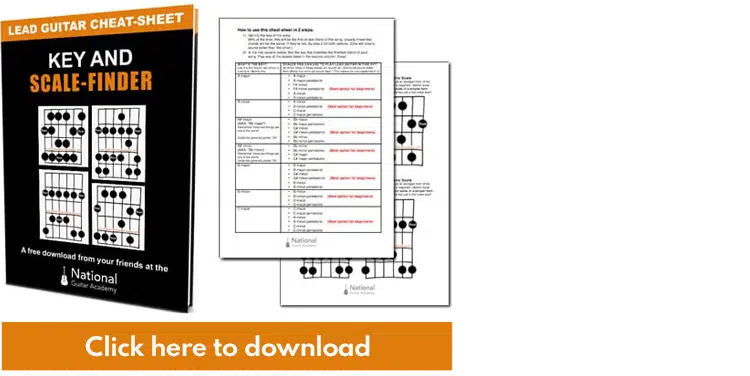
Get your personalised guitar-learning plan 🎸
Get a custom guitar-learning plan here: Click here for GuitarMetrics™
World-Class Guitar Courses 🌎
Learn from the world's best guitar educators: Click here for our guitar courses
So What Does A Lead Guitarist DO?
The most visible work of a lead guitarist is ripping into a solo in the middle of the song, but there’s much more to the role than just solos.
If you want to learn how to play lead guitar you need to learn how to contribute throughout an entire song. Not just in the solo!
A lead guitarist can drop in and out with complementary moments and melody lines which add to a song enormously.
[And not just with single notes, but with complementary riffs, licks, arpeggios, triads and effects. Lead guitarists have a wide and varied choice of tools.]
A Great Example Of Varied Lead Guitar
A great way to learn how to play lead guitar is to watch expert lead guitarists. This provides inspiration and ideas. Actively watch (don’t just enjoy the performance washing over you), study it! You’ll spot things you like and then you can learn them.
This is Jimmy Page and Led Zeppelin in 1973. Page does plenty of ‘flashy’ and eye-catching things, but there’s great variety and subtlety here too.
(The solo is blistering of course, but look at what he plays when he’s NOT playing the solo.)
Unsurprisingly, this can seem totally overwhelming for a beginner guitarist…
Learning how to play lead guitar can seem daunting, but it’s great fun and -like any challenge- you just need to break it down into smaller and more manageable steps.
It’s important to remember that there’s no ‘magic’ involved here. Anyone can learn how to play lead guitar. You just need to learn the building blocks of lead guitar technique. These are proven, repeatable steps that anyone can use, so please don’t feel like you aren’t ‘talented’ enough. (This is something I have heard many students say over the years and it’s simply not true. ‘Talent’ is a very small part of the equation.)
“Ok I’m ready, let’s do this! Tell me how to play lead guitar!”
Ok, clear your mind… Go in the zone and take this in! This is the main point of this whole guide:
How To Play Lead Guitar
There are millions of theories on this, and thousands of books on the subject, but essentially, a lead guitarist simply plays stuff that sounds good with the other stuff that’s being played.
That’s it, that’s all.
So how do we know what stuff will sound good with the other stuff?
Well, you need two pieces of information.
- You need to know the key of the song.
- You need to know the chords of the song.
(You can figure both of these out quickly and we’ll cover this later on in this guide.)
Once you have these two pieces of information you’re in business.
With these two pieces of information you can:
- Play notes from a scale that is complementary. (Thus, every note you play will ‘work’ and sound good!)
- Play alternate chord voicings, arpeggios and triads based on the chords. (These will all sound good, always.)
Ideally, you will do both of these things!
With these two pieces of information you will KNOW what notes you can play that will sound good. Good lead guitarists are never guessing; they know if a note will sound ok before they play it.
So as you can see, the first step in learning how to play lead guitar is understanding keys. That’s what we’re going to look at now.
Excited? You should be, you’re about to learn about the DNA of music – a huge part of learning how to play lead guitar. Let’s go!
Part 2 – The lead guitarist’s secret weapon: Keys
You are about to learn:
- Why keys matter
- How to identify a song’s key
- How to identify a scale that will work with the key of your song
How To Play Lead Guitar Ninja-Style!
The most important piece of information a lead guitarist needs to know is what key a piece of music is in.
“Why does a lead guitarist need to know the key of a song?”
When you’ve identified the song’s key, you can simply wail away in scale that complements the key. (We’ll cover scales later in this guide.)
When you play in a complementary scale you will know that every note you play within that scale will sound ok. (Some notes will sound better than others, but none of them will sound bad.)
This gives you the freedom to play whatever you want (from within that scale) and be safe in the knowledge that you won’t jam out a bad note. This means you can truly improvise. Huzzah!
How To Identify The Key Of A Song
To learn how to play lead guitar you must be able to quickly ‘diagnose’ keys.
Here’s a super-simple method to identify the key of a song: 95% of the time the key of a song is either the first or last chord.
Some specific examples:
- If a song starts and finishes with the chord of C, then the key of the song is C. (Or to use its full title, “C Major”.)
- If a song starts and finishes with the chord of Cm, then the key of the song is Cm.
What if a song starts or ends with a 7th chord?
- Treat major sevenths (eg Cmaj7, Dmaj7) as major chords.
- Treat minor sevenths (eg Am7, Cm7, Dm7) as minor chords.
- Dominant sevenths (eg A7, C7, D7, E7) can sometimes work with both major and minor scales. (Try both, see what sounds best!)
Let’s make this clearer with some specific examples:
- If a song starts and finishes with the chord of Cm7, then the key of the song is Cm.
- If a song starts and finishes with the chord of Cmaj7, then the key of the song is C. (AKA: “C Major”.)
- If a song starts and finishes with the chord of C7, then the key of the song might be C major or C minor. Try both.
Once again: 95% of the time the key of a song is either the first or last chord.
Pretty simple huh? This is vital part of learning how to play lead guitar. You’re off to a great start!
Let’s try this out. Can you tell the key of this song?
If we look at this simple progression….
A, D, A, E, D, A
The first chord is A, so we’re already starting to think that the song could be in the key of A. We need to confirm our theory.
If we look at the last chord…
A, D, A, E, D, A
We can see it’s also A.
This tell us the song is in the key of A major. Easy!
This means you can play any notes from the scale of A major and they will sound ok. (They will sound harmonious.)
This is a critical part of learning how to play lead guitar, so I hope you’re following this ok. Let’s look at some more examples.
Bonus Challenge!
Here is a blues chord progression. What key is it in?
- The first chord is E7.
- The last chord is E7.
- This song is in the key of E major, but because it’s using bluesy seventh chords a minor key will sound awesome too.
For dominant 7 chords (A7, E7, D7, etc) we can often use both major and minor scales.
So in this example, we could play anything in the scales of E major and E minor here. They would both work.
What if the first and last chords aren’t the same?
Try both!
Try the last chord first, as it will usually be the winner. Either way, you have a 50/50 shot at getting it right and you will quickly eliminate the wrong one.
Are there other ways to work out a song’s key?
Yes. There are more complicated ways to identify a song’s key, but for a beginner, they’re really not worth worrying about. (95% of the time, the first chord/last chord method above will work just fine.)
The acid test to check if you’ve correctly identified the song’s key is to play the scale for that key. (We’ll cover this in the next section.) If each note of the scale sounds ok over the song, then you nailed it. Well done!
Important point: Key’s can change!
While learning how to play lead guitar you must remember this: There are no absolute rules in music.
This means that a song can change key from moment to moment!
In my experience, about 90% of songs remain in one key for their entire duration. (This varies hugely by genre, of course.)
- In that other 10% there are tons of songs that have ‘black sheep’ chords. These are chords that don’t ‘fit’ into the same key of the rest of the song.
- Raising a song’s key during the outro is a common technique in pop music, but key changes are usually much more subtle than this type of ‘global’ raise.
- Sometimes, a song may switch key entirely for a bridge or chorus section and revert back to the established key during the verse.
So there will be plenty of times when you think you have the key of a song nailed down only to find there’s a curveball or one chord in the song where the scale you’re playing doesn’t work.
This means that learning how to play lead guitar can seem more difficult than it actually is.
But stick with the principles we’ve covered here and you’ll pick it up quickly.
Every piece of music is different and that variety is a big part of the joy of music. It’s all part of the fun! 🙂
CHECKPOINT: Consider your amp tone!

Even the best lead guitarist in the world can sound bad if their amp tone doesn’t blend well with the rest of the music.
Think carefully about this! It’s a huge part of learning how to play lead guitar.
- Do you want to use a clean channel? Or do you need a distorted/overdriven tone?
- Would some reverb help your sound ‘sit’ better in the mix?
- Does your guitar blend in or stand out more if your tone is bright and sharp? What happens when you turn up the bass and lower the treble?
- How does boosting the mid alter your tone?
- What pickup will you select and how will you dial your tone and volume controls? Try them in different positions.
Pro Tip: Beginner guitarists searching for an amp that will cover all the ground from rhythm to lead and everything in between will want an amp with a variety of available sounds.
We absolutely LOVE the BOSS Katana for this reason – it’s a versatile amp with a host of preset sounds to help you get familiar with different tones (and find your own sound too.)
If you’re looking for a versatile amplifier, look no further than the BOSS Katana 50w.
One of the best things about learning how to play lead guitar through an amp is the almost infinite tone combinations we can create. But most beginners fear experimenting with their amp tone in case they ‘mess it up’ or ‘lose’ a decent tone that it took them ages to stumble upon. Don’t be that guy or gal! Play around with your amp and experiment. Jump in with two feet! (You will be a much better guitarist for it.)
Ok, let’s move on and look at scales. This is going to be fun! 🙂
Part 3 – Guitar scales decoded: A simple explanation, at last!
Understanding scales is essential if you want to learn how to play lead guitar. (In the mind of lots of guitarists, scales ARE lead guitar.)
You don’t need to be a master. You just need to know the basics. Don’t worry, I’ll make it really easy to understand.
What is a scale?
A scale is simply a group of notes. That’s all.
You could pick a bunch of random notes and christen them the ‘random scale’ if you wanted. (Hey presto, you invented a scale!)
But there are two established scales that prevail and that music theory is based on. If you want to learn how to play lead guitar you need to know both.
The two scales every lead guitarist should know
There are two scales that you MUST know if you want to learn how to play lead guitar:
- The major scale
- The minor scale
Both of these scales have 7 different notes in them.
1, 2, 3, 4, 5, 6, 7
To make things easier for ourselves, we often play these two scales in a simpler form.
In these simpler forms, we take out 2 of the 7 notes.
1,2, 3, 4, 5
As you can see, this leave 5 different notes. And for this reason, we call the simpler scales ‘pentatonic’. (This is latin for “5 tones”.)
A pentagon has five sides:
A pentatonic scale has 5 notes.
This makes things a lot easier for you!
Why? Because instead of playing these two scales…
- The major scale
- The minor scale
…we can make life easier for ourselves by playing the two easy versions of those scales…
- The major pentatonic scale
- The minor pentatonic scale
In our quest to learn how to play lead guitar these two scales will be our best friends.
The scale we’re going to focus on today is the Minor Pentatonic scale.
The Minor Pentatonic Scale is one of the most commonly used scales in all popular music and is the easiest and most versatile scale to get started with.
For 99% of guitarists this is step one in learning how to play lead guitar.
Ready? Let’s do it! 🙂
Getting Started With The Minor Pentatonic Scale
For today’s lesson we’re going to use the minor pentatonic scale in the key of A.
That means the full name of the scale we’ll play here will be the “A Minor Pentatonic Scale”.
That’s a bit of a mouthful, I know. (But we’re stuck with it!)
(If you don't understand the above image please read our article "How To Read Guitar Chordboxes In 60 Seconds". It will make everything clear!)
This is ‘box 1’ of the minor pentatonic scale.
So what are guitar scale ‘boxes’?
You can play all guitar scales in 5 different ‘boxes’. A ‘box’ is simply a segment of the fretboard. (We have lots of frets on the guitar neck, so we have to divide them up.)
Just forget about boxes 2, 3, 4 and 5 for now. For your first 6 months of learning lead guitar, focus solely on box one.
Scale patterns stay the same, we just move them up and down the fretboard
One of the coolest things about guitar scales is they stay ‘fixed’ as you move them up and down the fretboard. This makes learning how to play lead guitar much easier!
The scale pattern doesn’t change. The only thing that changes is WHERE you start the pattern on the fretboard.
Let me explain. This is the minor pentatonic scale in all its glory:
On this image below, the thickest string (the 6th string) is on the far left. The thinnest string (the 1st string) is on the far right. If you don’t know how to read chordboxes like this, you should check out our article “How To Read Chordboxes In 60 Seconds“.
See the root note at the top left of the above picture? This is your starting point. This should be the first note you play.
- If you play this scale starting on the 1st fret, you will be playing F minor pentatonic. (Because the first note will be F.)
- If you play this scale starting on the 2nd fret, you will be playing F# minor pentatonic. (Because the first note will be F#.)
- If you play this scale starting on the 3rd fret, you will be playing G minor pentatonic. (Because the first note will be G.)
- If you play this scale starting on the 4th fret, you will be playing G# minor pentatonic.(Because the first note will be G#.)
Can you see how the scale we’re playing is ascending with each fret?
- The pattern that we move our fingers in remains the same.
- The only thing that changes is what fret we begin the pattern on.
This is crucial for learning how to play lead guitar. Let’s recap!
- Scale patterns are MOVEABLE.
- You can play them anywhere on the fretboard.
- What decides the tonality of the scale is WHERE you start playing it.
- Play the first root note (the farthest left root note on the scales shown above) to choose.
Here are the notes of the 6th string (the low E string):
- So, for example, if you start playing the minor pentatonic scale pattern on the 7th fret you will be playing the B Minor Pentatonic Scale.
- If you start playing the major scale pattern on the 10th fret you will be playing the D Major Scale.
- If you start playing the minor scale on the 3rd fret you will be playing the G Minor Scale.
How To Play Lead Guitar – The A Minor Pentatonic Scale
We’re going to use the A Minor Pentatonic scale as an example. (This means that the starting note of the scale must be A.)
So, we have to start playing the above scale patten on the 5th fret.
Hopefully, you can see why. (Because the note on the 5th fret of the 6th string is A.)
The correct fingers to use with the minor pentatonic scale
When we play the minor pentatonic scale we only ever play two notes per string. Easy!
- Fingers 1 and 4 on the E String.
- Fingers 1 and 3 on the A String.
- Fingers 1 and 3 on the D String.
- Fingers 1 and 3 on the G String.
- Fingers 1 and 4 on the B String
- Fingers 1 and 4 on the E String
You’ll notice that this is one-finger-per-fret. While you learn how to play lead guitar you should try and establish good habits. Good technique makes things easier! 🙂
If you want to learn how to play lead guitar you must get comfortable with this one-finger-per-fret hand shape.
This is me playing the Minor Pentatonic Scale. Click on the player below to listen.
Here’s the tab for what I just played. Can you see how it matches the chordbox pattern I showed you earlier?
This exact scale would sound fantastic with a piece of music that had a key of Am.
Understanding which scales to play with which key
Most of the time you will simply want to match the key of the music.
If the key is E major and you play the scale of E major, that will be a perfect match. It will sound great.
You can often play a minor scale over a major scale and it will sound awesome. (This works particularly well for rock, indie and blues.)
It doesn’t work the other way around. If you play a major scale over a minor key it will sound pretty weird. Go and try it! 🙂
We’re really getting into the heart of how to play lead guitar now, so let’s look at some specific examples.
Download our lead guitar cheat-sheet to make things easier
It's hard to understand which scales work with which keys.
So we created a cheat-sheet! A key and scale-finder that you can use again and again.

Get your personalised guitar-learning plan 🎸
Get a custom guitar-learning plan here: Click here for GuitarMetrics™
World-Class Guitar Courses 🌎
Learn from the world's best guitar educators: Click here for our guitar courses
If the song’s key was Bm, what would you do?
You would simply match the key. Play starting on the 7th fret (instead of the 5th) and this will make the root note of the pattern ‘B’. So the scale you would be playing would be B minor pentatonic.
Over time, we want you to memorise the notes of the 6th string (low E string):
I tell all my students to just remember the notes of the 3rd, 5th and 7th frets to begin with. These spell out “G.A.B”. These frets also have dots on them that help you get your bearings. With “GAB” in mind, you have a foothold on the fretboard and can work out other notes from there.
So you simply move the minor pentatonic scale pattern up and down the neck and begin on the root note that corresponds to the key.
Hey presto, you will be playing in a key that sounds great!
Ok, so the minor pentatonic scale sounds great over minor keys (and SOME major keys), but what about the others?
If the key is major then your minor pentatonic scale might not work. (It will work over lots of rock and blues though.)
In this case, the easiest thing to do is to ‘convert’ your minor pentatonic scale into a major pentatonic scale by moving it down 3 frets.
“What? That sounds crazy!”
Yes, I know, but this is a ninja tip, so concentrate and stay with me here!
This is an incredible timesaver for beginner guitarists.
It allows you to play in both minor AND major keys using just one scale pattern:
“That sounds great, but how does it work?”
Let’s look at an example.
Let’s say the key of an example song is C major. (One of the most common keys on guitar.)
You need to play in C major too. (C minor MIGHT work, depending on the style of music.) But C major WILL work.
If you play the above minor pentatonic pattern starting on the 8th fret, you will be playing C minor pentatonic. (Remember our notes from earlier.)
If you start playing this pattern on the 5th fret, you will be playing A minor pentatonic.
But, here’s the twist. There’s a weird thing in music theory where scales can be ‘relative’ to one another.
These two scales share the same notes:
- A minor
- C major
Don’t try and figure it out right now, it will make your head explode.
Just accept that it’s true! And be grateful for it, because it saves you a TON of extra work (and makes learning how to play lead guitar a lot easier).
This means you can play along to a song in the key of C major, by playing in A minor! (In reality, you will be playing C major, but you are just perceiving it as A minor.)
Let’s look at a real example
Find ‘C’ on the 6th string (the low E string).
As you can see, it’s on the 8th fret.
So we need to go DOWN 3 frets, to the 5th fret.
Going DOWN 3 frets is how we find a major key’s ‘relative minor’.
In your eyes, it would seem that we’re now playing in A minor. And that’s true.
However, we now know that the A minor scale shares the exact same notes as the C major scale.
These two scales are ‘relative’ to one another.
CRUCIAL POINT: You can play in ANY key, using this one pattern:
If we play the A minor pentatonic we will also be playing the C major pentatonic.
This 3 fret ‘space’ between a major and its relative minor applies for all chords and scales.
Relative majors and relative minors
He’s a quick overview of them all:
It’ll take you a while to get comfy with this concept.
During this time, it’s important not to get these the wrong way around!
If you want to learn how to play lead guitar, you must understand this. So let’s make it really clear….
If you want to play in a minor key…
Find the corresponding root note on the 6th string. Start playing the minor pentatonic scale there.
Easy!
If you want to play in a major key…
Find the corresponding root note on the 6th string. Move down 3 frets and play the ‘minor pentatonic scale’ there. Easy! (You will actually be playing the major pentatonic, but you will perceive it as the minor pentatonic – initially, at least.)
The relative minor to a major key is ALWAYS 3 frets lower.
(Conversely, the relative major to a minor key is ALWAYS 3 frets higher. But to work it out this way, you’d have to use a different scale pattern -the MAJOR pentatonic scale- and we won’t go into that here. You have plenty enough to get your teeth into already!)
I hope you’ve found this useful?
This is is really mind-blowing stuff for people who encounter it for the first time.
In my experience it takes EVERYONE a few weeks to wrap their heads around this concept.
If you are confused right now, please trust me that A) it’s normal to be confused and B) this knowledge will teach you how to play lead guitar. It really is all you need to know.
- Don’t worry if this doesn’t make sense initially. That’s normal.
- Play around with the concepts I’ve explained above and let it sink in. Return to this guide again and again.
- It will take time for you to internalise these concepts. You internalise them by playing.
You will need to read and play, read and play, read and play, several times before you internalize all this.
Most people need to see, think and do all of this from multiple perspectives before they truly understand how it fits together.
You may want to bookmark this article so you can return to it again in the future to revisit these concepts.
Ok, let’s move on and look at the next part of learning how to play lead guitar, the CAGED system!
INTERLUDE: Matching a scale to a key – one more example!
This is such an important point, I thought we’d include another example here.
Let’s say we want to play some lead guitar over a piece of music in the key of “D Major” (i.e., the first/last chord is D). In this situation what scales can you use?
Either the D Major Scale or the D Minor Scale.
It’s easiest to play these scales in their pentatonic form. So our options are:
- D Major Scale
- D Minor Scale
Or the abridged (and hence easier) version of the above scales:
- D Major Pentatonic Scale
- D Minor Pentatonic Scale
All these scales will work well over a piece of music in D major.
Learning how to play lead guitar means you need to be able to quickly diagnose keys. Practice this lots! 🙂
Ok, let’s move on to the CAGED system. This is so cool, you’re going to love this.






